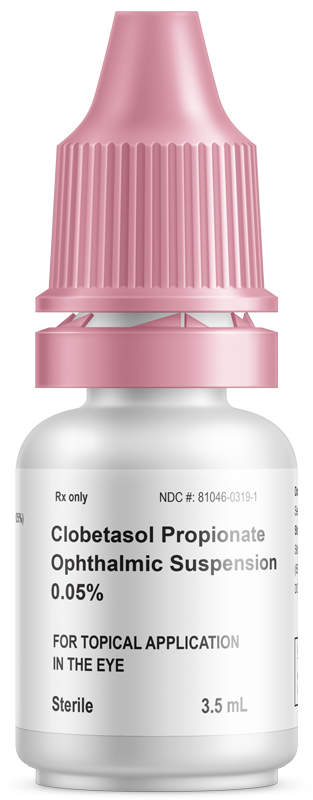Clobetasol Propionate Ophthalmic Suspension 0.05%
NOW COMMERCIALLY AVAILABLE
Clobetasol Propionate Ophthalmic Suspension 0.05% is approved for the treatment of post-operative inflammation and pain following ocular surgery, making it the first new steroid approved for eye care in 15 years.
Important Safety Information
HIGHLIGHTS OF PRESCRIBING INFORMATION
These highlights do not include all the information needed to use CLOBETASOL PROPIONATE OPHTHALMIC SUSPENSION 0.05% safely and effectively. See full prescribing information for CLOBETASOL PROPIONATE OPHTHALMIC SUSPENSION 0.05%.
CLOBETASOL PROPIONATE OPHTHALMIC SUSPENSION 0.05%, for topical ophthalmic use
Initial U.S. Approval: 1985
INDICATIONS AND USAGE
Clobetasol Propionate Ophthalmic Suspension 0.05% is a corticosteroid indicated for the treatment of post-operative inflammation and pain following ocular surgery.
DOSAGE AND ADMINISTRATION
• Instill one drop of clobetasol propionate ophthalmic suspension 0.05% into the affected eye twice daily beginning the day after surgery and continuing throughout the first 2 weeks of the post-operative period. (2.1) • Wash hands well before each use.
DOSAGE FORMS AND STRENGTHS
Ophthalmic suspension containing clobetasol propionate 0.05%.
CONTRAINDICATIONS
Clobetasol Propionate Ophthalmic Suspension 0.05% is contraindicated in most active viral diseases of the cornea and conjunctiva, including epithelial herpes simplex keratitis (dendritic keratitis), vaccinia, and varicella, and also in mycobacterial infection of the eye and fungal diseases of ocular structures.
WARNINGS AND PRECAUTIONS
• Intraocular Pressure (IOP) Increase: Prolonged use of corticosteroids may result in glaucoma with damage to the optic nerve, defects in visual acuity and fields of vision. Steroids should be used with caution in the presence of glaucoma. If this product is used for 10 days or longer, IOP should be monitored.
• Cataracts: Prolonged use of corticosteroids may result in posterior subcapsular cataract formation.
• Delayed Healing: The use of steroids after cataract surgery may delay healing and increase the incidence of bleb formation.
• Corneal and Scleral Melting: In those diseases causing thinning of the cornea or sclera, perforations have been known to occur with the use of topical steroids. The initial prescription and renewal of the medication order should be made by a physician only after examination of the patient with the aid of magnification, such as slit lamp biomicroscopy, and where appropriate, fluorescein staining.
• Bacterial Infections: Prolonged use of corticosteroids may suppress the host response and thus increase the hazard of secondary ocular infections. In acute purulent conditions, steroids may mask infection or enhance existing infection. If signs and symptoms fail to improve after 2 days, the patient should be reevaluated.
• Viral Infections: Employment of a corticosteroid medication in the treatment of patients with a history of herpes simplex requires great caution. Use of ocular steroids may prolong the course and may exacerbate the severity of many viral infections of the eye (including herpes simplex).
• Fungal Infections: Fungal infections of the cornea are particularly prone to develop coincidentally with long-term local steroid application. Fungus invasion must be considered in any persistent corneal ulceration where a steroid has been used or is in use. Fungal culture should be taken when appropriate.
ADVERSE REACTIONS
Ocular adverse reactions occurring in ≥ 1% of subjects in clinical studies who received clobetasol propionate ophthalmic suspension 0.05% included eye inflammation (2%), corneal edema (2%), anterior chamber inflammation (2%), cystoid macular edema (2%), intraocular pressure elevation (1%), photophobia (1%) and vitreous detachment (1%). Many of these reactions may have been the consequence of the surgical procedure (6.1). To report SUSPECTED ADVERSE REACTIONS, contact Formosa Pharmaceuticals at 1-833-393-6684 or FDA at 1-800-FDA-1088 or www.fda.gov/medwatch.


